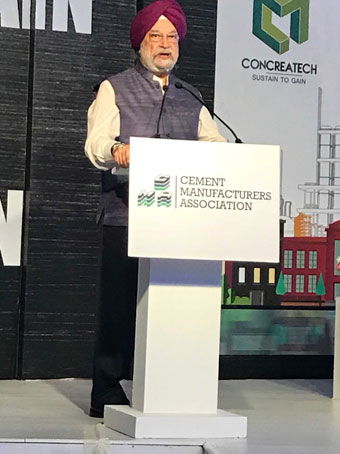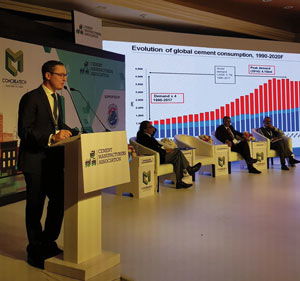Industry leaders met in New Delhi yesterday for 'Concreatech 2018 – Sustain to Gain', a summit organised by the Cement Manufacturers' Association (CMA), to discuss the cement sector's role in national development and commitment to low carbon industrial development.
Delegates were told that the Indian cement industry is on track for high growth as it commits to sustainable growth and ambitious CO2 reduction targets.

Mr Hardeep Singh Puri, Minister of State
of Housing and Urban Affairs
In his opening address, Dr Shailendra Chouksey, President, CMA, outlined the progress made by the cement industry, which has seen it rise to be the second largest cement producing nation in the world, with a cement capacity of over 500Mta, accounting for eight per cent of global installed capacity. Domestic demand is accelerating and is expected to grow by 12-14 per cent in 2018. Sustainable growth is a cornerstone for the industry, which is committed to a 40 per cent reduction in CO2 emissions by 2050.
In his keynote address to delegates, Mr Hardeep Singh Puri, Minister of State of Housing and Urban Affairs, stressed India's commitment to sustainability ideals, having played a leading role in shaping the Sustainable Development Goals, and the importance of sustainable growth for India where economic expansion and responsibility toward the climate can no longer seen as mutually exclusive. "We have to get over this zero-sum mindset which pits development against our responsibility towards the climate," he said.
On India's current development agenda, Mr Puri highlighted the current administration's achievements, including delivering on major sanitation programmes, such as the construction of 6.7m toilets by October 2019, 2400 projects worth INR740m under the Atal Mission for Rejuvination and Urban Transformation (AMRUT) programme, and 11m homes by 2020 under the PMAY affordable housing initiative.

Thomas Armstrong, Managing Editor of ICR,
provided a regional industry overview
Opening the panel discussions, Thomas Armstrong, Managing Editor of International Cement Review, provided a regional industry overview and highlighted the sharp downturn in Chinese consumption in 2018, which will see global demand fall by four per cent. Meanwhile, demand in other Asian markets remains strong, with India set to trend at seven per cent annual growth over the medium-term, supported by strong urbanisation trends and high levels of investment in infrastructure and affordable housing.
K K Maheshwari, Managing Director, UltraTech Cement Ltd, India's largest cement producer, noted how the Indian cement sector has maintained new capacity additions on the expectation of continued demand growth, resulting in the accumulation of significant overcapacity. Producers should be prepared to weather further swings in the pace of growth as India develops, but utilisation levels should gradually improve.
The programme also saw the release of the "Low Carbon Roadmap for the Indian Cement Sector: Status Review 2018" by the Cement Sustainability Initiative (WBCSD), comparing progress made by the industry since the initial CO2 emission reduction commitments were made in 2010.
The report confirms that direct CO2 emission intensity has fallen by 32kgCO2/t cement to 588kg CO2/t cement in 2017, representing a five per cent reduction compared to the baseline year of 2010.
Commenting on the report, Mr Mahendra Singhi, Vice President, CMA and CEO, Dalmia Cement (Bharat) Ltd, argued that the results confirm the Indian cement industry's status as one of the most energy-efficient and sustainable industries in the world. He called upon cement business leaders to take a more ambitious approach to CO2 reduction, arguing the sector should ultimately aim to surpass carbon neutrality and ultimately achieve carbon negativity in cement production. This can only be achieved, he conceded, with the support of other industries to develop cost-effective carbon capture and valorisation technologies.
